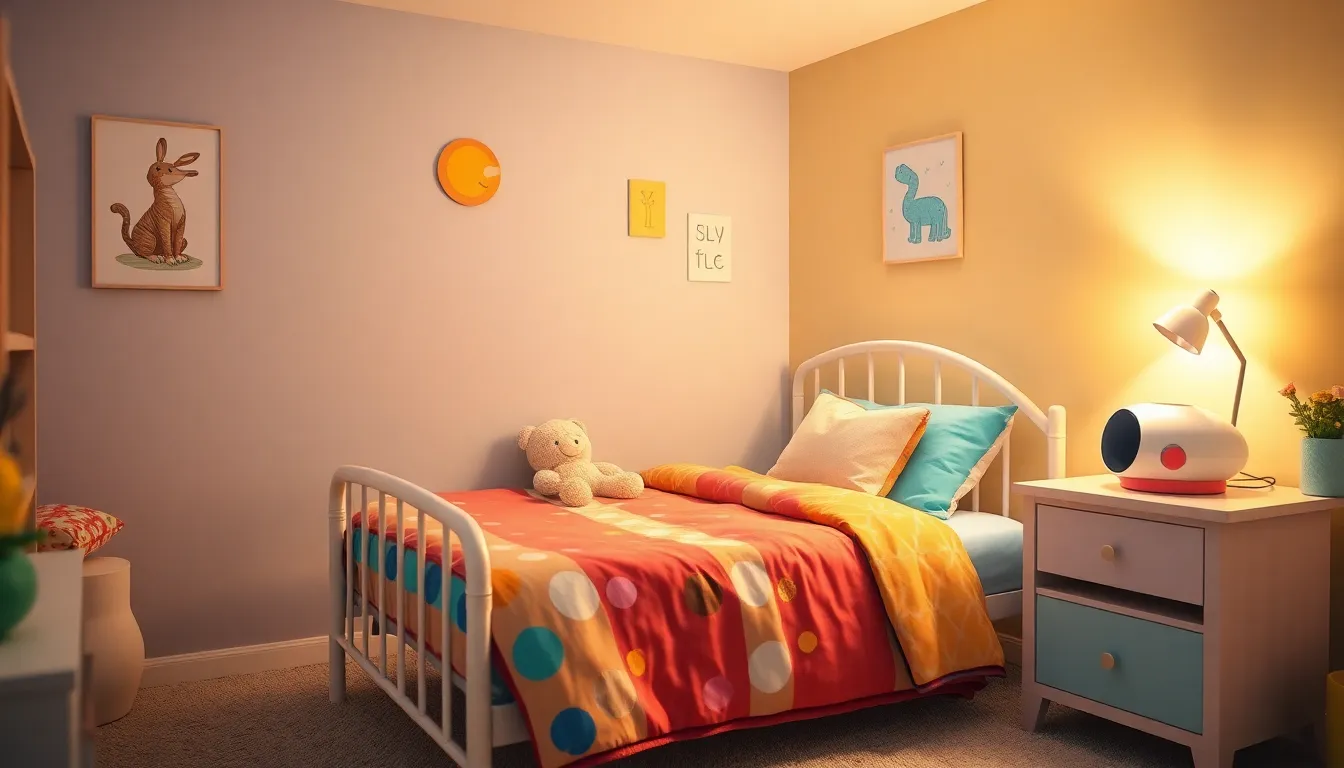Every parent knows that a well-rested toddler is a happy toddler. Yet, getting little ones to embrace sleep can feel like trying to teach a cat to fetch. If bedtime battles are turning into epic showdowns, it’s time to explore some effective sleep training tips that could turn the tide in your favor.
Table of Contents
ToggleUnderstanding Sleep Training
Sleep training helps toddlers develop healthy sleep habits. This process involves various methods aimed at teaching children how to fall asleep independently.
What Is Sleep Training?
Sleep training refers to techniques designed to assist toddlers in learning how to sleep without help. This practice often includes establishing a bedtime routine and gradually teaching children to settle down on their own. Parents typically choose a particular method, like the Ferber method or no-tears approach, based on their child’s temperament and family preferences.
The Benefits of Sleep Training for Toddlers
Sleep training offers numerous advantages for both toddlers and parents. Improved sleep quality leads to better mood regulation in children. Consistent sleep patterns can reduce nighttime awakenings, allowing parents to enjoy uninterrupted rest. Enhanced self-soothing skills empower toddlers to manage sleep transitions independently. Additionally, sleep training can establish a sense of security, providing a calming bedtime environment essential for healthy development.
Preparing for Sleep Training

Preparing for sleep training requires a clear understanding of your toddler’s unique needs and environment. A well-planned approach sets the stage for successful sleep habits.
Assessing Your Toddler’s Sleep Needs
Evaluating sleep needs begins with observing patterns in your toddler’s behavior. Signs of tiredness include rubbing eyes, yawning, or crankiness. Comparing these behaviors with age-specific recommendations offers valuable insight into appropriate bedtime. Children aged 1-2 years generally need 11-14 hours of sleep, which includes daytime naps. Keeping a sleep log helps track data and identify trends. Tailoring the approach based on individual needs fosters a more effective sleep training process.
Choosing the Right Sleep Environment
Creating an optimal sleep environment enhances the chances of success in sleep training. Start by ensuring the bedroom is dark, quiet, and cool, as these factors promote relaxation. Personalizing the space with familiar objects, like a favorite blanket or stuffed animal, contributes comfort and security. Using white noise machines can mask disruptive sounds that might wake a sleeping toddler. Finally, consistent bedtimes and routines signal to both the child and parent that it’s time to wind down, further reinforcing a calming atmosphere.
Popular Sleep Training Methods
Various sleep training methods help toddlers learn to sleep independently. Parents can choose from different approaches based on their preferences and their child’s temperament.
Ferber Method
The Ferber Method involves allowing toddlers to self-soothe for gradually increasing intervals. Parents first establish a bedtime routine that prepares the toddler for sleep. Initial is short intervals of 3 minutes, followed by extended waits of 5, 10, and 12 minutes. Consistency during this training ensures toddlers learn to fall asleep without assistance within 1-2 weeks. Many parents find this method effective in encouraging self-soothing.
Chair Method
The Chair Method offers a gentler approach, focusing on gradual distance. This method requires parents to sit in a chair near the toddler’s bed during the transition. Over several nights, parents slowly move the chair further away, reducing their presence while maintaining support. This technique fosters comfort and reassurance, as toddlers become accustomed to drifting off without parents close by. Many families appreciate this gradual transition and the emotional support it offers.
No Tears Method
The No Tears Method emphasizes comforting toddlers without letting them cry. This approach incorporates strategies such as gentle patting or verbal reassurance to soothe the child back to sleep. Establishing a consistent bedtime routine is crucial for ensuring relaxation. This method aligns well with sensitive toddlers who may struggle with separation anxiety. Parents often favor it for maintaining a peaceful atmosphere during bedtime.
Implementing Sleep Training
Implementing sleep training effectively requires attention to routine and commitment from caregivers. Specific steps can enhance the overall success of the process.
Creating a Consistent Bedtime Routine
A consistent bedtime routine establishes predictability for toddlers, signaling that it’s time to wind down. Starting with calming activities, like reading or taking a warm bath, can help prepare them for sleep. Timing is essential, so beginning this routine at the same time each night fosters habit formation. Incorporating quiet time can ease the transition to sleep, making it smoother. Ending with a final goodnight reinforces security and love, allowing toddlers to feel settled.
Tips for Staying Committed
Staying committed to sleep training is crucial for success. Establish expectations as a family, ensuring everyone understands the importance of bedtime consistency. Avoiding deviations, like skipping routines or altering bedtimes significantly, maintains stability. Tracking progress can motivate parents and highlight improvements, encouraging continued efforts. Finding support from parenting groups or resources can provide encouragement and helpful suggestions. Lastly, celebrating small milestones keeps everyone motivated and invested in the process.
Troubleshooting Common Sleep Issues
Parents often face a variety of sleep-related challenges with toddlers. Understanding potential issues helps identify solutions effectively.
Nighttime Fears
Nighttime fears often arise during toddler years. Shadows or unfamiliar noises may trigger anxiety in children. To combat this, consider establishing a comfort routine. Reading a favorite book before bed can create a sense of security. Providing a nightlight or familiar stuffed animal reassures the toddler during the night. Engaging in discussions about fears also helps. Allowing children to express their feelings creates an open environment, reducing anxiety.
Sleep Regression
Sleep regression can occur unexpectedly, often at milestones such as changing routines or teething. These phases typically last from a few days to several weeks. Consistent bedtime routines remain crucial during these times. Sticking to previously established habits provides security amidst disruption. Parents should monitor sleep patterns closely and respond appropriately to changes. Sleep logs help identify unique regressions. Adjusting expectations and practicing patience supports both parents and toddlers through this period.
Establishing healthy sleep habits for toddlers can transform bedtime struggles into a peaceful routine. By implementing effective sleep training methods and creating a calming environment, parents can help their little ones learn to sleep independently. Understanding each child’s unique needs is key to tailoring the approach, ensuring a smoother transition to restful nights.
With commitment and consistency, parents can navigate common challenges like nighttime fears and sleep regressions. Celebrating small victories along the way fosters a positive atmosphere for both parents and toddlers. Ultimately, a well-rested child contributes to a happier family dynamic, paving the way for better days ahead.



